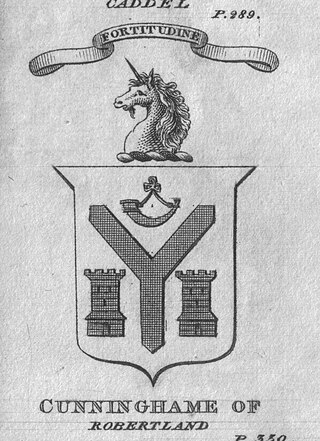Related Research Articles

Dunfermline Palace is a ruined former Scottish royal palace and important tourist attraction in Dunfermline, Fife, Scotland. It is currently, along with other buildings of the adjacent Dunfermline Abbey, under the care of Historic Environment Scotland as a scheduled monument.

Thomas Hamilton, 1st Earl of Haddington, designated before his peerage as 'of Drumcarny, Monkland, and Binning', was a Scottish administrator, Lord Advocate, judge, and Lord Lieutenant of Haddingtonshire.

Ludovic Stewart, 2nd Duke of Lennox and 1st Duke of Richmond, lord of the Manor of Cobham, Kent, was a Scottish nobleman who through their paternal lines was a second cousin of King James VI of Scotland and I of England. He was involved in the Plantation of Ulster in Ireland and the colonization of Maine in New England. Richmond's Island and Cape Richmond as well as Richmond, Maine, are named after him. His magnificent monument with effigies survives in Westminster Abbey.

George Home, 1st Earl of Dunbar, KG, PC was, in the last decade of his life, the most prominent and most influential Scotsman in England. His work lay in the King's Household and in the control of the State Affairs of Scotland and he was the King's chief Scottish advisor. With the full backing and trust of King James he travelled regularly from London to Edinburgh via Berwick-upon-Tweed.
William Fowler was a Scottish poet or makar, writer, courtier and translator.

Sir David Cunningham of Robertland, in Ayrshire, was Master of Works to the Crown of Scotland from 1602 to 1607, and Surveyor of the King's Works in England from 1604 to 1606
James Elphinstone, 1st Lord Balmerino (1553?-1612) was a Scottish nobleman and politician, disgraced in 1609.

Baillie John MacMorran (1553-1595), a merchant and Baillie of Edinburgh, was killed during a riot at Edinburgh High School. His house at Riddle's Court is a valued monument on Edinburgh's Lawnmarket.
Sir John Preston, Lord Fentonbarns, of Penicuik, was a Scottish lawyer and judge who became lord president of the court of session.

Gilbert Primrose was a Scottish surgeon who became Surgeon to King James VI of Scots and moved with the court to London as Serjeant-Surgeon to King James VI and I on the Union of the Crowns. He was Deacon of the Incorporation of Surgeons and Barbers of Edinburgh on three occasions.
Margaret Hartsyde or Hairtsyde was a Scottish servant, jewel thief, and landowner. A servant of the queen, Anne of Denmark, Hartsyde's duties included looking after the queen's jewels, dealing with the goldsmith George Heriot, and handling large sums of money.
Barbara Ruthven was a Scottish courtier and favourite of Anne of Denmark, expelled from court after the death of her brother.

Dr Martin Schöner or Schönerus, physician to James VI and I and Anne of Denmark.
Sir James Anstruther of Anstruther, was a Scottish landowner and courtier.
Alexander Barclay was an apothecary in Edinburgh.

John Norlie was an English musician at the Scottish royal court.

Jacques de Bousie was a Flemish confectioner known as a "sugarman" working in Edinburgh, Scotland, employed by James VI and Anne of Denmark.
John Wolfgang Rumler was a German physician and apothecary in Augsburg, known for his Observationes medicae, who eventually served the English royal family in the households of Prince of Wales, Queen Anne, King James and Charles I of England. He is also credited with making blackface theatrical grease-paint.

Peter Sanderson was an Edinburgh tailor who worked for Anne of Denmark wife of James VI of Scotland.
Hans Poppilman was a Danish cook who served Anne of Denmark in Scotland and England.
References
- ↑ Elizabeth Lane Furdell, The Royal Doctors, 1485-1714: Medical Personnel at the Tudor and Stuart Courts (New York, 2001), pp. 115, 121.
- ↑ Michael Lynch, Edinburgh and the Reformation (Edinburgh: John Donald, p. 320: John Graham Dalyell, Journal of the Transactions in Scotland, by Richard Bannatyne (Edinburgh, 1806), p. 314.
- ↑ Charles Thorpe McInnes, Accounts of the Treasurer, vol. 12 (Edinburgh, 1970), pp. 152-3.
- ↑ Marguerite Wood, Extracts from the Records of the Burgh of Edinburgh, 1589-1603 (Edinburgh, 1927), pp. 218, 362-4.
- ↑ Leslie Gerald Matthews, The Royal Apothecaries (London, 1967), p. 88: Thomas Rymer, Foedera, vol. 16, pp. 522, 532-3.
- ↑ L. G. Matthews, London's Immigrant Apothecaries, Medical History, 18 (1974), p. 263.
- ↑ David Masson, Register of the Privy Council of Scotland, 1613-1616, vol. 10 (Edinburgh, 1891), p. 160.